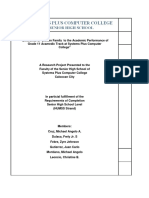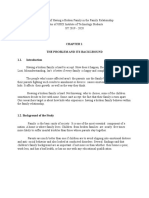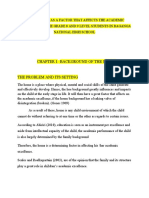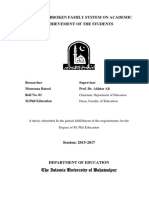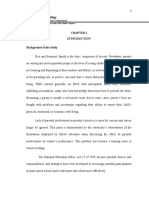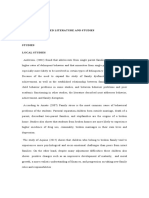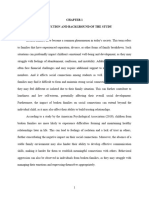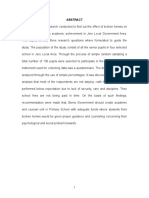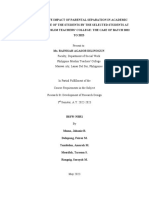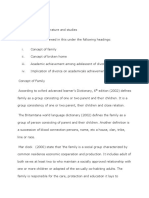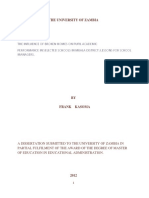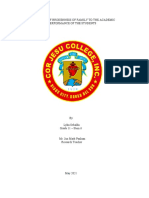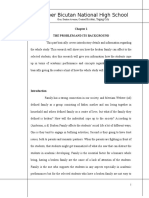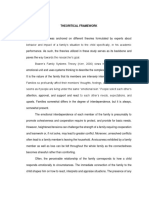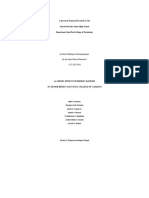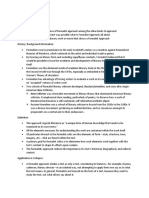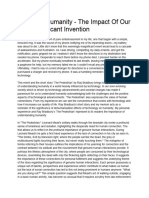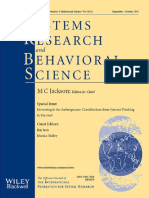“A Broken Family’s Battle:” A Qualitative Study on the Experiences of MHPNHS
Students Dealing with Family Fragmentation
Category: Phenomenology
Proponents:
Marc Vryant De Guzman
Vincent Paul Eballo
Czarina Mae Mamaril
Rhone Christian Salcedo
Louis Andrei Santiago
John Lester Zamora
Research Teacher
Marcelo H. Del Pilar National High School
March 2020
i
� Table of Contents
Title Pagei
Table of Contents................................................................................................................ii
Introduction......................................................................................................................1
Statement of the Problem.................................................................................................1
Purpose of the Study........................................................................................................2
Significance of the Study.................................................................................................2
Definition of Key Terms..................................................................................................3
Scope and Delimitations..................................................................................................3
Review of Related Literature...........................................................................................4
References..........................................................................................................................11
ii
� Introduction
Introduction
Every child's dream is to gain a perfect relationship and a perfect family. Here in
the Philippines, divorce is still not legalized because Filipinos believe in the sanctity of
marriage. However, there are still married couples who get separated through annulment.
Before, couples who had differences or fight against each other still try to fix their
marriage because of their children, but modern families have separated from this
prospect.
The broken family is a family that contains a separated parent. Their children tend
to live with one of their parents. The broken family often leads to negative results on the
student's lives. Family's involvement is recognized as a primary factor into children's
whole being [ CITATION Les17 \l 13321 ]. A broken family, in a broader sense, is a family
that has missing members (i.e. lost sibling/s, dead parent/s, etc.).
Statement of the Problem
The focus of the study is to discover the effects of a broken family among the
teenagers. Specifically, it seeks to answer the problems including the attitude of the
teenager (having a broken family) in his/her community, the causes of having a broken
family, the effect of having a broken family to their lives, and lastly, the solutions that
can help a teenager prevent a broken family.
General Research Question:
1. What are the characteristics of family fragmentation, its causes, and its effects
on students?
1
�Specific Research Question:
1. What are the experiences of students belonging in a broken family?
2. How well do students dealing with family fragmentation fare in school?
3. Can the severity of effects in students be different in:
a. Separated parents?
b. Lost sibling/s?
c. Lost parent/s?
d. Separated sibling/s?
Purpose of the Study
Family fragmentation has different effects on the members of the family
especially the children, may it be academically, emotionally, socially, or physically. This
study aims to identify the characteristics of family fragmentation, what causes said
societal issue and the experiences of students belonging to a broken family and the effects
on their lives. This would be done through the use of questionnaires, interviews, and
observations.
Significance of the Study
The researchers believed that this study will be beneficial to the students, parents,
teachers, and to future researchers. This may provide them with the information that they
need in order to be aware and to further extend the knowledge of the students. For
students, this will provide information about the various effects of being or having a
fragmented family and how they deal with it. Next, for parents, this will raise their
2
�awareness to the possible impact of having a fragmented family towards students’
academic performance, and to help them enhance their relationship with their child.
Then, for teachers, this will also be beneficial to the educational institutions for them to
assist or help students who are in a fragmented family. And lastly, for the future
researchers, this would help them in their future studies that can be used as their related
topics and this may serve as knowledge and guidance for their study.
Definition of Key Terms
Broken family is the state of the incompleteness of a family, whether it may be
the death of a loved one, broken marriage, or the loss of a member due to certain
circumstances. This is one of the most common factors that affect the mentality of
modern families especially the youth.
Family fragmentation is the breakage of the family through the loss of siblings,
parents or the separation of the member from the family. This is possible due to certain
misunderstandings, divorce, or the change of heart of one parent and can no longer
provide a strong connection to the family.
Estrangement is the state of no longer being in good terms in a family. This can
be caused by a lot of factors, example of this are differing beliefs, physical or mental
abuse, overbearing grandparents, the refusal to apologize, and finally, the crossing of
boundaries may it be privacy, personal space, or decision making.
Youth delinquency is the immoral or illegal acts that the youth is committing.
This can lead to punishments like probation or juvenile detention.
3
�Scope and Delimitations
The study is limited only on studying the experiences of students that deals with
family fragmentation, it will not include the likes of which can be considered “broken”
such as families with abusive parents, rebellious children, etc. This study will only focus
on students of Marcelo H. Del Pilar National High School and will not include students
from other schools. Extraneous variables that will come up during experimentation will
not be studied further.
Review of Related Literature
Rising rates of divorce and consequent family fragmentation have always
troubled child and family welfare. Though divorce seems to be an obvious cause for
concern, there are yet many other factors that amplify disintegration of families but are
hardly even considered to be domestic issues. The rising rate of family fragmentation
does not only happen in the Philippines, but all around the world. Family is the basic unit
of society, if someone had a family problem it could lead to a bigger aftermath. The
effects of family fragmentation to families but specifically, students are essential in order
to provide answers, because in providing answers and solutions to problems, it may not
solve the problems quickly, but it could lead to a certain theory on how to avoid said
problems. The researchers wanted to study the effects of family fragmentation to students
because family fragmentation seems to be a very difficult problem in our society, this can
lead to very bad effects on families and especially the children, and they want to help
formulate a solution on how they can help the said victims. As our society progress,
many studies involving fragmented families showed many effects regarding the problem,
4
�some showed how it affected families legally, some showed the effects emotionally, and
some showed physical damage.
When the separation of spouses by divorce happens, it leads to a fragmented
family which then affects their children (Batool, 2017). Globally, in the nearly four
decades between 1970 and 2008, the divorce rate has more than doubled from 2.6
divorces for every 1,000 married people to 5.5 (DePaulo, 2019). Next, according to
Churchill & Fagan, students who experienced their parents’ divorce or separation are less
likely to complete high school. An Australian study led by Evancs, Kelly, and Wanner
(2001) discovered that students of divorced families are more likely to drop out of
secondary school than students raised in intact families, and found that remarriage did not
alleviate the effects of divorce on student’s educational attainment (Fagan & Churchilll,
2012). Following to the Australian study, they found that students who experience
separation of their parents early in life are likely to have lower educational outcomes,
finding that the effect of divorce on education is strongest when the child is young. Then,
an American study led by Lansford (2006), found that those who had experienced a late
divorce or between grades six and ten, were more likely to get low grades than students
who experienced an early divorce or between kindergarten and grade five (Fargan &
Churchill, 2012). However, these statements were focused only on the effects on the
student's educational outcomes, and not on the broader effects such as the effects of
fragmented family on the socialization of students in school. As the research progresses,
it will add its discussion of the effects on the student’s family as the basic unit of society
has different characteristics and each children belonging to various family types has
varying experiences.
5
� Everyone aims for a healthy and happy family, but many could not achieve it.
Due to different problems, healthy families have been broken up as well. When unwanted
things come up, many families have been broken, and the members are separated. This is
a tragedy happening out of unrestricted reasons as well as unfortunate reasons (Saikia,
2017). In connection with this, children are deprived of proper emotional and physical
support from their parents. In such families, the basic needs of children are not fulfilled
properly and effective socialization of values are not totally possible. Igbinosa (2014)
declared in his paper that the environment of home put a great impact on the performance
of a student. Children experience problems in school with teachers, acting out against
peers, and generally, they do not want to cooperate with assignments, instructions of
teachers, and have concentration difficulties. In support with Igbinosa’s statement,
adolescents of separated parents have lower scores on measures of well-being (i.e.,
academic functioning, locus of control, and self-esteem) compared to adolescents of
intact families (Shirina, 2013). However, not all children react the same way as those that
were mentioned, some of them cope with their situation positively that made them accept
their family’s status eventually. As time goes by, many researchers took time to know
more about the other aspects that family fragmentation affects.
Certain researchers have thought if there are consequences to a student’s
academic performance when faced with the issue of family fragmentation. Many have
ventured in observing the relationship between family connections and academic
performance and have been innovating on data-gathering techniques to observe the
correlations of the two variables (Park & Halloway, 2013; Robinson & Harris, 2014;
Miller, 2015), it is natural that alongside these are researches investigating family
6
�fragmentation’s correlation on academic excellence. According to Jeynes (2002), the
study of the relationship between family and academic performance can be traced back
90 years ago when Sutherland (1930) found significant difference in IQ between children
with only one parent and children with a complete set of parents. However, Sutherland
was unable to explore further on the several different types of single-parent households.
This shortcoming was fixed by Nye in 1952 when he took into account the several factors
of single-parent households such as gender, number of siblings, work, etc. He found a
significant difference between mother-only households and stepfather-only households,
but it is in terms of adjustment and Nye noted that the difference was not as big as once
thought. This has led researchers to look at the topic in several different perspectives
which led to more studies on family fragmentation and its effects on the academic
performance of students. (Düşek, 2014; Omoyuri, 2014; Batool, 2015) However, the
articles, although they are qualitative, are limited to using quantitative data and methods
to represent the academic excellence of students. The articles were not able to observe the
overall academic performance of the respondents and their experiences in school
objectively. This approach will also affect the data gathered for a significant number of
types of family fragmentation.
Family fragmentation have always troubled child and family welfare. According
to Amato (2010) in recent decades, family changes in different ways, including the
increasing rate of divorce and separation. Children who does not live with their biological
parents tend to have difficulties in schooling, mental health and other things than children
who lived with their parents. In this case, Harkonen and many others (2010) managed to
create a study observing the outcomes of a child with a fragmented family. In their
7
�context, the children affected by parental separation experience great trouble in their
behavior, studies, and relationships. Following this, according to Liu, Li, and Ge (2009)
separation of parents in childhood significantly increased the probability of children to
have depression and anxiety. Even though separation of parents could result depression,
there would be less chance of this kind of mental issues to children who was adopted
earlier after the separation of the parents (Pesonen, Raikkonen, Heinonen, et al., 2006;
Liu, Li, & Ge, 2009). However, the stated effects of separation were not the only effects
that could come up during this kind of problems. They only concentrated on the main
aspect of mental health of the affected person. Recent work had begun to challenge the
effect of loss parents into the children to understand clearly the relationship of family.
Another cause of family fragmentation is the loss of siblings. According to Jason
Fletcher (2018), although childhood mortality rates have plummeted over the past
century in developed countries, it is still experienced in 5 to 10 percent of the US’
population. It has strong and durable negative long-term effects on the surviving relatives
in the long run and little is known on the development of children who experienced the
death of a sibling in the medium run. This is because of a children’s vulnerability, lack of
skills, and their ability to impact the future they are heading to. In accordance to the
article, it is known to us that we can extend the understanding of the effects on the
children who lost a sibling by estimating the surviving sibling’s cognitive and
socioemotional outcomes, as well as emotional and cognitive support by parents. Firstly,
when the cognitive outcomes were tested, it was found out that there is a decrease in the
surviving child’s ability to solve mathematical equations, reading comprehension, and
even the child’s vocabulary, and eventually, the child improves 11 years after the passing
8
�of a sibling. Next, in terms of socioemotional outcomes, it is found out that certain
behavioral problems worsen and there are significant reductions in the child’s own self-
perception. They also tested the effects on a home environment and it was found out that
emotional resources in the household are significantly lowered. In other words, the
parents and surviving children feel sadness and depression, and these effects do not
diminish over time. But in the contrary, it was found out that the loss of a sibling made
the surviving children more competent and allowed them to be more goal-oriented and
competent. These effects can be greatly affected by the age of the surviving and deceased
children, if the surviving children are older, it may decrease the effects due to their
emotional stability, and if otherwise, the death of a sibling will have a much greater effect
on the younger ones due to their vulnerability and lack of emotional stability.
Another cause of the fragmentation of a family is when a parent or both parents
die. "The death of a parent is a highly stressful life event for bereaved
children."(Bergman, Axberg, & Hanson, 2017) It is proven that there is a severe increase
in the risk of mental health and psychosocial problems. The article used a population of
parentally bereaved children around 0 to 18 years of age. The results showed that both
the remaining parent and children showed a major change in the intervention to groups,
peers, and other parents, but the article mainly focused on the bereaved children and the
effects of the loss of their parents. It showed that the children were more likely to adapt
some sort of mental disorder like depression, present grief and anxiety. It also showed
that the remaining parent may become sad for a while but eventually becomes a much
better parent that supports their children in most of the things they do. As a result, they
tend to become more careful and protective of their children. This parental treatment
9
�from the remaining surviving parent makes it easier for the children to cope with the loss
and eventually move on with their lives. But it will never be the same given that on most
cases, the children may have moved on but still showed cases of sadness and surges of
depression.
The sibling relationship is simply powerful, and critically important in an
individual’s life. According to Silverstein and Smith (2009), the longest relationship in
the life of a person is it relationship to it brothers and sisters. Sibling separation occur
thousands of cases each year. Therefore, Ruksana Saika, a researcher in India, conducted
a study in the effects of being separated into your family. The study showed a numerous
number of effects that separation could bring into the children life. In response to this
observation of the effects, a study by Mchale Uperdegraf, and Whiteman in 2012
investigated and focused about the effects of sibling experiences and relationships. The
study also showed that siblings had a great influence, and effects of other significant
relationships. Following this, according to Child Welfare Information (2019),
maintaining sibling bonds is a key component of child welfare. Sibling relationships help
children achieve developmental milestones as well as provide emotional support,
companionship, and comfort in times of change. When children are separated from their
siblings, the research indicates that a number of children feel “they have lost a part of
themselves,” which compounds the anxiety and pain they feel over separation from their
parents and transition to a new home. (Kernan, 2017, Child Welfare Information, 2019)
However, this studies mainly focuses on the great effects of having a better relationship
of the siblings. Overall, being separated to a member of the family causes a lot of major
effects in the well-being of the children.
10
� Being in a fragmented family greatly affects the students’ behavior most
specifically their attitude towards academic excellence. It has a huge impact that most of
the student subjected to this often feel lonely, depress, anxious or etc. Since family
should be the one to mold and guide the children during their adolescence, those who are
involve in a fragmented family often seek this support and attention from others that
made them feel more about the void that they have. Based on the information that were
collected, students in a fragmented family have low academic performance and the
causes for it varies. They are often engaged in physical fights too. But some of these
children have already made a coping mechanism and continue to strive every day and
eventually accept their situation.
Methodology
Introduction
The research process and its details will be explained in this part of the paper. The
methodology will provide information about the process used to conduct this study, as
well as the appropriateness of the several aspects of the research process. The reliability
of the chosen design, sampling method, and target sample size is evaluated. The data
gathering methods, the chronology in which the methods will be done, and how the data
gathered would be analyzed is evaluated. The researcher's role is defined and evaluated
and the validity and reliability of the study will be discussed.
Design
The research will apply the phenomenology design for this qualitative research
which examines thoughts, emotions, behavior, and several other aspects in the mind of
people experiencing different phenomena. In this case, the study investigates the
11
�phenomenon “family fragmentation” and its effects on students. This design is
appropriate since the research will show if family fragmentation serves any purpose or
meaning to the lives of students. Since phenomenology is qualitative, the proponents will
employ qualitative research methods as this study will contribute to social science.
Sampling
This research will use non-probability sampling methods since the research is
qualitative. Firstly, the availability sampling procedure will be used for selecting the
respondents. The proponents will collect data from the population who are available to
participate when in demand. Availability sampling is appropriate to use as it is
convenient and data collection can be facilitated in short duration of time. After
collecting the result in this procedure, the next step is to use judgmental sampling for
those who are fitted to represent the population for the study.
Judgmental sampling will be used to develop the sample of the research under
discussion. In this sampling procedure, sample members are selected on the basis of their
knowledge, relationships, and expertise regarding the phenomenon, namely family
fragmentation. This sampling procedure is appropriate for the study since the proponents
will be able to judge and evaluate the respondents if they have sufficient and relevant
experience with family fragmentation and if those experiences would be substantial to the
study. The participants chosen for this procedure needs to consent to the study first.
Sample
For some studies, the population may be small enough to attain the participants
needed in the study. But a study may entail a large population which cannot all be
studied. That portion of the population that is studied is called a sample of the population.
12
�A sample in this study is, therefore, a smaller group of elements drawn through a definite
procedure from an accessible population. The elements making up this sample are those
that agreed to be included in the study. This study aims to gather 8-10 students from
Marcelo H. del Pilar National High School as long as they are willing to participate and
have experiences the proponent think will be relevant to the study.
Data Gathering Methods
In the first part of data gathering, the proponents will use the questionnaire
method in which the chosen samples will be given a questionnaire and their answers will
determine who will participate in the next part of the data gathering process. This method
will be used in order to filter the samples and bring together a group of participants
considered to be part of a fragmented family that is suitable and willing to participate.
Using this method will also save time and resources because looking for suitable
participants is less time-consuming compared to waiting for willing participants.
The next part of the data gathering process will involve the usage of the focus
group discussion method which this means that the filtered participants from the previous
method will be put together in a group interview that will give way to the understanding
of the experiences of students belonging to a fragmented family. This method will be
used because it is much more convenient than conducting an interview because the
participants will be congregated into a group, thus, allowing the proponents to ask a
question to the entirety of the group and not just one individual. This method will also
make the participants much more comfortable in sharing their experiences because they
will be able to relate to one another rather than the confined atmosphere when it comes to
a one-on-one interview.
13
� When given consent, the proponents will use observational evaluation in selected
and willing participants. The participants will be observed in their natural settings like at
home, school, gatherings, etc. This method will be the most crucial and helpful out of all
the methods to be used in this study because it will show the proponents the reality of
what family fragmentation entails in its truest, physical form. From there, the proponents
will not only have the statements and perspective from the participants, but also the
physical evidences of the participants’ experiences in which the proponents can use to
evaluate the effects of family fragmentation from their perspective. The use of this
method will add more accuracy and substance to the observation of the phenomenon’s
effects on students.
Data Analysis Procedure
Interpretation of results would be based on the participants’ responses to the
questionnaires provided by the proponents. The proponents will interpret the data
gathered through questionnaire and interview and will use it to develop a conclusion. The
proponents will use coding as the data analysis procedure for the interpretation of data.
Coding is the most commonly used data analysis procedure for qualitative research,
making it SDhhsd for the study. The data gathered should be able to show the collective
effects of family fragmentation on MHPNHS students from the participants since using
coding requires the analyzation of behavioral patterns based on their responses.
Conclusion
The methodology serves as an outline for the research process and a guide to
several parts of the study systematically. The aim of this study is to evaluate the
experiences of students experiencing family fragmentation subjectively yet remaining as
14
�unbiased as possible. The sampling, data gathering, and data analysis methods used are
purely qualitative to make the study more holistic and relatable. The next part will
discuss the analysis procedure in detail and interpret the results gathered in doing the
study.
References
Batool, M. (2015). Impact of Broken Family System on Academic Achievement of the
Students.
Bergman, A.-S., Axberg, U., & Hanson, E. (2017). When a parent dies – a systematic
review of the effects of support programs for parentally bereaved children and
their caregivers . BMC Palliative Care .
DePaulo, B. (2019, February 3). Divorce Rates Around the World: A Love Story.
Psychology Today.
Düşek, G., & Ayhanb, A. B. (2014). A study on problem solving skills of the children
from broken family and full parents family attending regional primary boarding
school. Procedia - Social and Behavioral Sciences 152, 137-142.
Evans, M. D., Kelley, J., & Wanner, R. A. (2001). Educational attainment of the children
of divorce: Australia, 1940-90. Journal of Sociology 37, 287.
Fargan, P. F., & Churchill, A. (2012). The Effects of Divorce on Children. MARRI
Research Synthesis, 29-30.
Fletcher, J., Vidal-Fernandez, M., & Wolfe, B. (2017). Dynamic and heterogeneous
effects of sibling death on children’s outcomes . PNAS, 115-120.
Harkonen, J., Bernardi, F., & Boertien, D. (2017). Family Dynamics and Child
Outcomes: An Overview of Research and Open Questions. European Journal of
Population, 163-184.
Igbinosa, V. O. (2014). Influence of Broken Homes on Academic Performance and
Personality Development of Adolescence in Lagos State Metropolis. European
Journal of Educational and Development Psychology, 10-23.
Jeynes, W. (2002). Divorce, Family Structure, and the Academic Success of Children.
London: Routledge.
Kernan, E. (n.d.). RESOURCES. Retrieved from National Center for Youth Law:
https://youthlaw.org/publication/keeping-siblings-together-past-present-and-
future/
15
�Lansford, J. E. (2006). Trajectories of Internalizing, Externalizing, and Grades for
Children Who Have and Have Not Experienced their Parents' Divorce or
SeparationWho Have and Have Not Experienced their Parents' Divorce or
Separation. Journal of Family Psychology 20, no. 2, 296.
Li, X., Liu, Z., & Ge, X. (November 2009). Left Too Early: The Effects of Age at
Separation From Parents on Chinese Rural Children’s Symptoms of Anxiety and
Depression. RESEARCH AND PRACTICE, 2049-2054.
McHale, S. M., Updegraff, K. A., & Whiteman, S. D. ( 2012 ). Sibling Relationships and
Influences in Childhood and Adolescence. NIH Public Access, 913–930.
Miller, S. B. (2015). Review of The Broken Compass: Parental Involvement with
Children’s Education by K. Robinson and A. Harris. Education Review, 22.
Paik, L. (2017). Good parents, bad parents: Rethinking family involvement in juvenile
justice. Theoretical Criminology, 307-323.
Park, S., & Holloway, S. D. (2013). No Parent Left Behind: Predicting Parental
Involvement in Adolescents’ Education Within a Sociodemographically Diverse
Population. The Journal of Educational Research, 1-15.
Pesone, A.-K., Raikkone, K., Heinonen, K., Kajantie, E., Forsen, T., & Johan G.
Eriksson, J. G. (2007). Depressive Symptoms in Adults Separated from Their
Parents as Children: A Natural Experiment during World War II. American
Journal of Epidemiology, 126–1133.
Robinson, K., & Harris, A. L. (2014). The Broken Compass: Parental Involvement with
Children’s Education. Cambridge: Harvard University Press.
Saikia, R. (2017). Broken family: Its causes and effects on the. International Journal of
Applied Research, 445-448.
Shirina, A. (2013). Effects of Family Breakup on Children: A Study in Khulna City,
Bangladesh. e-Journal of Sociology, 10.
Sibling Issues in Foster Care and Adoption. (2019). BULLETIN FOR PROFESSIONALS.
16



